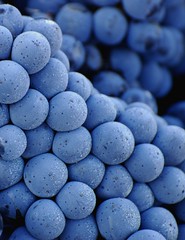On the 2nd evening in Beirut there was party sponsored by the seminar organization in a hip restaurant/bar (The Library) where we got some nice food, but unfortunately the wine wasn't too good and the entertainment was a bit too loud to allow easy talking.
We drank a Reserve de Couvent 2007 from Ksara Winery. Even though this wine won at least two silver medals this year I am afraid we drank it somewhat too young.
It anyhow contained too much acids and too little taninnes to really be enjoyed with the steak that was server for dinner.
Luckily the next day we had more luck as we went for dinner in The Exchange next to the hotel where we drank the delicious 2003 (sic!) Chateau Kefraya made by Kefraya winery. The acidity and tannins are in perfect balance with this wooded wine with a lot of alcohol (14.5%) that really came close to some not so cheap bordeaux wines that I drank a while ago.
This 2003 vintage was much better than the 2005 one we drank two days earlier. On the winelist they also posted a prestigious Le Comte de M by Kefraya which is the topwine, but as it was 3 times the price I did not select it.


![Reblog this post [with Zemanta]](http://img.zemanta.com/reblog_e.png?x-id=6b9644e1-90a9-4bf9-ad69-9f3708e5bbe3)
![Reblog this post [with Zemanta]](http://img.zemanta.com/reblog_e.png?x-id=75809b80-ff53-4d7b-8aca-5b75323a29c1)

![Reblog this post [with Zemanta]](http://img.zemanta.com/reblog_e.png?x-id=bd9d7ff6-a905-49a9-82e7-49da87f2454a)



![Reblog this post [with Zemanta]](http://img.zemanta.com/reblog_e.png?x-id=40196fee-cc22-4932-a074-a6f6b5aafbba)
![Reblog this post [with Zemanta]](http://img.zemanta.com/reblog_e.png?x-id=d1f234bf-86f5-4955-912f-301c7a5a7c08)

![Reblog this post [with Zemanta]](http://img.zemanta.com/reblog_e.png?x-id=c1c8591d-44b1-48b2-951c-5eed7c163fbd)

![Reblog this post [with Zemanta]](http://img.zemanta.com/reblog_e.png?x-id=b5a4990b-0031-48ea-859a-f7164950d045)
![Reblog this post [with Zemanta]](http://img.zemanta.com/reblog_e.png?x-id=5693bd9a-b8a0-443d-8836-0b9ea2ea7e49)
 This wine was part of a set of 6 bottles that we got when we were 10 years married and was in fact the start of a real wine cellar in our basement.
This wine was part of a set of 6 bottles that we got when we were 10 years married and was in fact the start of a real wine cellar in our basement.![Reblog this post [with Zemanta]](http://img.zemanta.com/reblog_e.png?x-id=50ec54bb-6165-43a7-9799-f78439a45120)
![Reblog this post [with Zemanta]](http://img.zemanta.com/reblog_e.png?x-id=302e7a78-729d-4bfe-8568-7f152e1c5533)

![Reblog this post [with Zemanta]](http://img.zemanta.com/reblog_e.png?x-id=1765f3ed-a581-4e52-b9c9-d623955c0cfe)
![Reblog this post [with Zemanta]](http://img.zemanta.com/reblog_e.png?x-id=35e2dd7c-1fa5-43fe-a13e-37a9759cdcf1)
![Reblog this post [with Zemanta]](http://img.zemanta.com/reblog_e.png?x-id=feb0bd10-a617-4420-a28b-36de2d3634d4)
![Reblog this post [with Zemanta]](http://img.zemanta.com/reblog_e.png?x-id=6cb3e16a-b53b-47cf-8678-aea1be5ac9b0)

![Reblog this post [with Zemanta]](http://img.zemanta.com/reblog_e.png?x-id=16b3ee70-83bf-4164-bc15-1605a368a512)
![Reblog this post [with Zemanta]](http://img.zemanta.com/reblog_e.png?x-id=055ef85b-4ad9-41ab-98b8-2a6e53320cba)
![Reblog this post [with Zemanta]](http://img.zemanta.com/reblog_e.png?x-id=b757cb4c-eb6d-4ba3-8177-867ab5aa3ea7)
![Reblog this post [with Zemanta]](http://img.zemanta.com/reblog_e.png?x-id=8090969f-01ec-472d-85e8-a4bac8f7e8ca)
![Reblog this post [with Zemanta]](http://img.zemanta.com/reblog_e.png?x-id=57a00433-fc37-444b-9659-68afb9da3896)
![Reblog this post [with Zemanta]](http://img.zemanta.com/reblog_e.png?x-id=0c93d0da-1873-4fc2-9449-e907177ef654)
![Reblog this post [with Zemanta]](http://img.zemanta.com/reblog_e.png?x-id=a43f823d-e735-48d0-b07e-acefd47f784e)
![Reblog this post [with Zemanta]](http://img.zemanta.com/reblog_e.png?x-id=12f8c9e9-e268-4160-85d0-51e4e2cabe7c)

![Reblog this post [with Zemanta]](http://img.zemanta.com/reblog_e.png?x-id=dae7d97d-7792-4aab-8b30-21b8a23107d7)